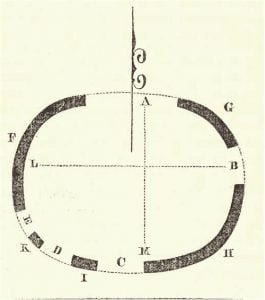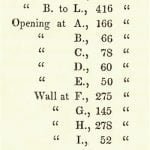
The eminence called “Fort Hill”, at one time called Osco, 1 in the southwestern skirts of the village of Auburn, has attracted notice from the earliest times. Its height is such as to render it a very commanding spot, and crowned, as it was, with a pentagessimal work, earthen ramparts and palisades of entire efficacy against Indian missiles, it must have been an impregnable stronghold during the periods of their early intestine wars. The following diagram, drawn by James H. Bostwick, surveyor, and obligingly furnished by S, A. Goodwin, Esq. exhibits its dimensions:
The site of this work is the highest land in the vicinity, and a visit to it affords one of the best and most varied views of the valley of the Owasco, and the thriving and beautiful inland town of Auburn, with its public buildings, prison, 2 and other noted public edifices. The ellipsis enclosed by the embankments, with their intervening spaces, has a circumference of 1200 feet. Its minor dimensions are as follows, namely:
Viewed as a military work, the numerous breaks or openings in the wall, marked from A. to C., constitute rather its characteristic trait. They are of various and irregular widths, and it seems most difficult to decide why they are so numerous. If designed for egress or regress, they are destitute of the principle of security, unless they were defended by other works of destructible material, which have wholly disappeared. The widest opening [of 166 feet,] opens directly north, the next in point of width [78 feet,] directly south; but in order to give these or any of the other spaces the character of entry or sally ports, and, indeed, to render the entire wall defensible, it must have had palisades.
Immediately below the openings at E. D. C., and a part of the embankment F., there are a series of deep ravines, separated by acute ridges, which must have made this part of the work difficult of approach. In front of the great (north) opening, the ground descends gradually about seventy feet, when there is a perfect acclivity. The hill has its natural extension towards the east, for several hundred yards, in the course of which, a transverse depression in the surface separates the eastern terminus of the ridge from its crown at the site of the fort.

It is not known that excavations have been made for antiquarian remains, so that there is no accessory light to be derived from this source. The entire work conforms to the genius and character of the red races who occupied the Ohio valley, and who appear to have waged battle for the possession of this valuable part of the country, prior to the era of the discovery of America, and ere the Iroquois tribes had confederated and made themselves masters of the soil. That the art of defense by field works was cultivated by the ancient American tribes, is denoted by their traditions, as well as by the present state of our antiquarian knowledge. This art did not aspire to the construction of bastions, at the intersection of two right angled lines, by means of which a length of wall might have been enfiladed with arrows. Even where the works were a square or parallelogram, of which there are one or two instances among the oldest class of forts, such an obvious advantage in defense does not appear to have occurred. Fire, and the coal chisel, or digger, were the ready means of felling trees and of dividing the trunks into suitable lengths for palisades. To heap a pile of earth within and without such lines, was the mode adopted by the Tuscaroras at the siege of Naharuke, in 1712, and it is probable that this then powerful and warlike nation had inherited much of the skill in fort building possessed by their northern predecessors.
The chief point, in addition to its numerous breaks in the wall, before noticed, in which this work differs from the generality of antique native forts of the oldest period in this State, is its very well preserved elliptical form. A circle is the usual form of the antique forts of Indian origin in western New York; and these works are generally placed on the apex of a hill, covered by ravines as a natural moat, or they occupy an eminence which commanded other advantages. For the original communication and survey, above referred to, see letter E., documentary appendix.
Citations:
- This ancient name for the site of Auburn was communicated to me by the intelligent Onondaga Taht-kaht-ons, or Abraham Le Fort. It is descriptive of the ford or crossing-place, which anciently existed above the falls, near the site of the present turnpike bridge. This was crossed by stepping-stones, &c. The barks, which made a part of a rude Indian bridge, were, at the time the name was bestowed, nearly overflowed; the crossing was very dangerous, as it was just above the brink of the falls, and it was an act of daring to pass over. The name bestowed at this time became perpetual, although there may have been but little danger in crossing afterwards.[
]
- One of the most striking evidences of that tendency of the surface limestone stratification of western New York to assume a fissured character, marked by the cardinal points, is seen in the banks of the Owasco, a short distance below the State prison.[
]
